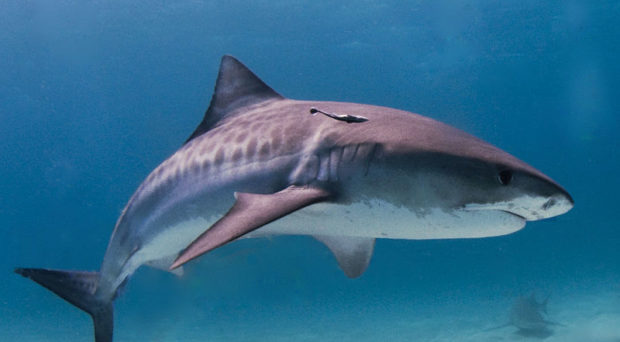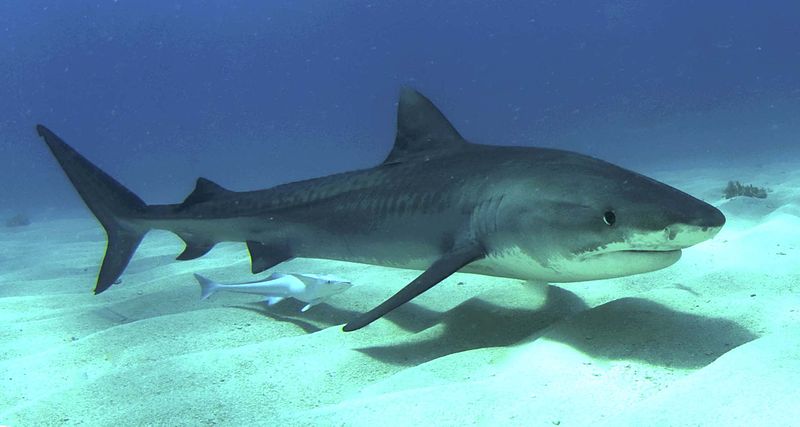
Sharks were among the first animals to evolve live birth. Today, around 70% of sharks give birth to live young, the rest laying eggs.
All developing shark embryos are initially nourished by a foetal yolk-sac. For egg laying species, this yolk will be sufficient to see embryos through to hatching, when the infant sharks will begin to feed independently.
In live birthing species however, mothers supply additional nutrition once the yolk-sac has been depleted. The exact form this additional maternal care takes varies considerably from species to species.
Some species produce a mucus in the uterus for the growing embryos to feed on, while in others a supply of unfertilised eggs is provided for the embryos to eat. Many shark species use the more familiar (to we mammals) strategy of direct nutrient exchange between mother and fetus via a placenta.
Requiem for a placenta
Placental development is thought to have evolved just once in sharks, being found only amongst the 270 species of the ground shark order (Carcharhiniformes).
One of the families in this order is the requiem sharks (Carcharhinidae), a group containing many familiar species like the blacktip and bull sharks. All 60 species of requiem sharks have placenta apart from one: the tiger shark. Instead, as recent research has shown, tiger shark mothers provide nutrients for their developing embryos by filling the egg case with an energy rich fluid.
As the closest relatives of tiger sharks are placental, it is likely that its ancestors did have a placenta which was later lost during their evolution. Such a dramatic shift in reproductive strategy is rare; once a species has evolved placental reproduction, few cases are known of their descendants losing this ability.
Tiger sharks thus provides a unique opportunity to look at the genetic changes associated with the loss of a placenta. This is what a team of researchers, led by Vincent Savolainen at Imperial College London, have done in research published this week in BMC Evolutionary Biology.
Chasing the tracks in their genes
The team took muscle samples from one individual tiger shark and individuals from five placental requiem shark species, all sampled off the coast of the Bahamas. They then sequenced the transcriptomes of these 6 species, along with transcriptomes of two species from different shark families (one placental, one non-placental) to act as genetic outgroups for the comparisons among the requiem sharks.
By constructing a phylogenetic tree of the relationships among the species, the researchers were able to look for evidence of positive selection on certain tiger shark genes. Differences in the transcriptome of tiger sharks compared to their placental relatives implies these genes were associated with the loss of the placenta.
Their results found evidence for positive selection linked to placental loss in genes in two areas: sexual reproduction and brain development.

Selection on sexual reproduction
Researchers detected signatures of positive selection on the genes TCTEX1D2 and VAMP4, both known to be involved in sperm production. The protein coded by TCTEX1D2 is required for cilia function and is found in the flagellum of sperm in many taxa, including humans, mice and teleost fish. Deletion of VAMP4, meanwhile, has been linked to sperm abnormalities in mice.
Given what is known about these genes, the researchers speculate that the changes seen in their expression in tiger sharks could mean that loss of the placenta has caused changes in sexual behaviour.
With a gestation period of 15-16 months (substantially longer than their placental relatives), and a year of sexual inactivity following birth, female tiger sharks only breed around once every 3 years. Conversely, male tiger sharks breed annually. This implies that there will be substantial competition among males during breeding. Females are likely to breed with multiple males, and so this competition is likely to take place post-copulation through sperm competition.
Past research has shown that tiger sharks have relatively shorter sperm than other sharks; shorter sperm usually means males can produce more of it, a benefit in sperm competition. Thus, we might speculate that the changes in TCTEX1D2 and VAMP4 reflect an increase in sperm count (and subsequently shorter sperm) by male tiger sharks to adapt to increased sperm competition, itself caused by the changes in female breeding patterns due to the loss of the placenta.

Selection on brain development
Signatures of positive selection were found in two genes linked to brain development, ARL6IP5 and YWHAE.
The brain is one of the most energetically expensive organs to develop and for this reason non-placental sharks are expected to have relatively smaller brains. Notably then, the YWHAE gene has been linked to brain development in humans, mice and drosophila. Potentially, changes in this gene are due to the tiger shark adapting to the reduction in energy available to the developing embryo due to the loss of the placenta.
The other gene, ARL6IP5, encodes a transmembrane protein known to inhibit the transport of glutamate through the brain. When deprived of oxygen, glutamate levels increase, causing neuronal death and potentially brain damage.
Tiger sharks, with their near global distribution and ability to exploit a wide variety of habitats and food sources, often find themselves in low-oxygen environments. For most shark species, such habitats would result in a lack of oxygen reaching the brain; it seems possible then, that an increase in ARL6IP5 expression is an adaptation to enable tiger sharks to exploit oxygen-poor environments in their pursuit of prey.
The past will be clearer in the future
As the researchers are quick to point out, these results are only preliminary. Future sequencing of DNA from a greater variety of sharks (in particular comparisons with the few other shark species known to have secondarily lost placentas), and more individuals from each species, will of course improve our ability to identify genetic footprints caused by loss of the placenta.
Until recently, very little research had been conducted on sharks at the genomic level, primarily due to the massive size of their genomes; over 30 Gb per haploid genome, compared to, for example, 1.4 Gb for a zebrafish. However as DNA sequencing becomes ever cheaper, we are likely to see more and more data collected for these kinds of studies.
For now, we can be content with these tantalising glimpses of the genetic changes and evolutionary adaptations caused by this dramatic and unusual evolutionary loss.
Comments